

HOJA 164. Google Play. Diseño Instruccional: Diseño Instruccional. El diseño instruccional, elemento esencial para planear, diseñar, implementar y evaluar contenidos educativos digitales.
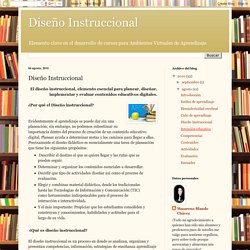
¿Por qué el Diseño instruccional? Evidentemente el aprendizaje se puede dar sin una planeación; sin embargo, no podemos subestimar su importancia dentro del proceso de creación de un contenido educativo digital. Planear ayuda a determinar metas y los caminos para llegar a ellas. Ex aprendizaje. Experiencias de aprendizaje: realmente existen y… funcionan. Una experiencia de aprendizaje debe ser un modelo de formación y desarrollo que: - Tiene por objetivo construir conocimientos y experiencias trabajando a partir de situaciones de desempeño y entornos de trabajo individual y grupal. - Combina soluciones de comunicación, aprendizajeaplicación, participación e incentivación. - Integra metodologías blended learning a través de un mix de actividades presenciales y on line mucho más allá de las soluciones tradicionales (sesión de formación y/o píldora interactiva). - Incorpora como elemento clave las opiniones y aportaciones de los participantes.

182698s. EVA4. Modelos de Diseño Instruccional. Definitions of Instructional Design. History of the ADDIE Model. ADDIE (Analysis, Design, Development, Implement, and Evaluate) is a model of the ISD family (Instructional System Design).
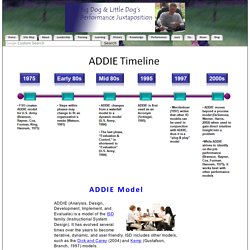
It has evolved several times over the years to become iterative, dynamic, and user friendly. ISD includes other models, such as the Dick and Carey (2004) and Kemp (Gustafson, Branch, 1997) models. While the concept of ISD has been around since the early 1950s, ADDIE first appeared in 1975. It was created by the Center for Educational Technology at Florida State University for the U.S. Army and then quickly adapted by all the U.S. As defense machinery was becoming more and more sophisticated, the educational background of entry level soldiers was becoming lower and lower. The ADDIE or ISD model consisted of 19 steps that were considered essential to the development of educational and training programs (Hannum, 2005).
Revised ADDIE Model Six years later, Dr. Roots and Connections of ADDIE and ISD. While Ludwig von Bertalanffy created the general systems theory in the 1950's, it took several others to create a few basic instructional, learning, and training concepts that tied system theory to the ISD or ADDIE model that we know today.
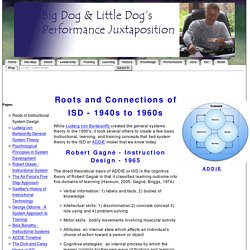
Robert Gagnè - Instruction Design - 1965 The direct theoretical basis of ADDIE or ISD is the cognitive theory of Robert Gagnè in that it classified learning outcome into five domains of learning (Hannum, 2005; Gagnè, Briggs, 1974): Verbal information: 1) labels and facts, 2) bodies of knowledge Intellectual skills: 1) discrimination 2) concrete concept 3) rule using and 4) problem solving Motor skills: bodily movements involving muscular activity Attitudes: an internal state which affects an individual's choice of action toward a person or object Cognitive strategies: an internal process by which the learner controls his/her own ways of thinking and learning Gain attention: Present a problem or a new situation.
B.F. Documento6. 4 Pasos D. 4 Pasos D. Spanish SelfDirectedGuide. DOC Conocimiento. El Diseño de experiencias significativas en entornos de aprendizaje. El Diseño de experiencias significativas en entornos de aprendizaje Rosmery Dussán Aguirre * (*) Diseñadora Industrial (ICESI).
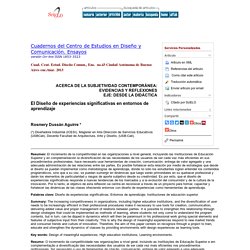
MASLOW. Motivar al alumnado hacia el aprendizaje es uno de los caballos de batalla permanentes en el trabajo de todos los docentes.
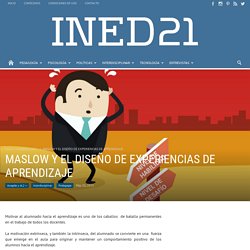
La motivación extrínseca, y también la intrínseca, del alumnado se convierte en una fuerza que emerge en el aula para originar y mantener un comportamiento positivo de los alumnos hacia el aprendizaje. Qué enriquecedor resulta mirar hacia teorías que nos ayudan a reflexionar sobre nuestro trabajo. Home. Designing Engaging Online Learning Experiences. Kirsten Peterson, a highly experienced instructional designer and instructor, leads EDC’s EdTech Leaders Online team in providing capacity-building, research-based programs, courses, and services that enable organizations to build successful online and blended learning experiences for K–16 students, teachers, and adult learners.
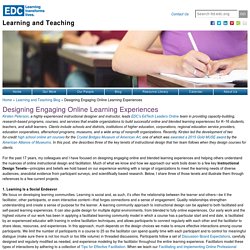
Clients include schools and districts, institutions of higher education, corporations, regional education service providers, education cooperatives, afterschool programs, museums, and a wide array of nonprofit organizations. Recently, Kirsten led the development of two for-credit high school online art courses for the Crystal Bridges Museum of American Art, one of which was awarded a 2015 Gold MUSE award by the American Alliance of Museums. In this post, she describes three of the key tenets of instructional design that her team follows when they design courses for clients. Designing Significant Learning Experiences. Diseño de Experiencias de Aprendizaje. ED 626: Software Design and Authoring. Educational Studies School of Education University of Michigan Fall term 1996 Mondays 4:00-7:00 PM in 2211 (the Multimedia Classroom) on the second floor of the School of Education Welcome to a pratical course that explores the relation of educational software design and authoring Contents Introduction ED 626: Educational Software Design and Authoring (3 credits) Students identify significant educational problems and design, try out, and revise software or computer applications in the effort to solve these problems.

Return to contents The following assumptions are made: Understanding of technology comes from practice as well as study; All technology is value laden; Technology should make work easier, better or help us to do that we cannot now do; and The study of software design and paradigms of authoring systems allows use unique opportunities to understand the interplay of technology and learning. The philosophy of the course Meaningful learning occurs when people solve authentic problems. Roots and Connections of ADDIE and ISD. Basic Teaching Model by Robert Glaser (1962) It is a psychological teaching model and was developed by Robert Glaser in 1962.

This model explains the relationship between teaching and learning. It is basic model based on basic principles of psychology. Las fuentes del currículo. III.1.
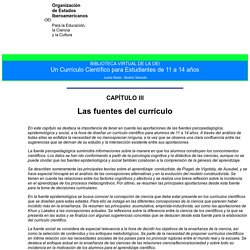
PechaKucha 20x20. Instructional Design for Online Training. La formación en Internet: Guía para el diseño de materiales didácticos - Julio Cabero, Mercè Gisbert Cervera, Merce Gisbert. Books.google.com. formación en Internet Página 2 guía para el diseño de materiales didácticos Mercè Gisbert Cervera. La formación en Internet Guía para el diseño de materiales didácticos LA FORMACIÓN EN INTERNET LA FORMACIÓN EN INTERNET GUÍA PARA. Julio Cabero y Mercè ...
Página 5. Disenoinstruccional.pdf (objeto application/pdf) T. MARZANO y KENDALL - Página Jimdo de educamoseducandonos. Objetivos. Nueva taxonomía. Nueva taxonomía - Marzano y Kendall. Competencias Digitales y la nueva Taxonomía de Bloom. ¿Usted sabe qué es la taxonomía de Bloom? La taxonomía de Bloom busca clasificar los objetivos educativos. En el año 1956, crea su famosa “Taxonomía de Bloom”, la cual es una herramienta clave para estructurar y comprender el proceso de aprendizaje, ligada siempre al dominio cognitivo, el cual busca procesar la información y desarrollar habilidades mentales.
Luego en el año 2001, Lorin Anderson, un estudiante de Bloom, revisa y actualiza la taxonomía de su maestro y la denomina “Taxonomía revisada de Bloom”. Lo que actualiza es el reemplazo de sustantivos por verbos para cada categoría, la cuales se caracterizan por ser de orden ascendente. A continuación una imagen ilustrativa:
Teorías. Modelos. La enseñanza en competencias en el marco de la educación a lo largo de la vida y la sociedad del conocimiento. Andragogía. Diseño Instruccional Final. INTRODUCCIÓNEs de gran importancia la estructuración o forma que el diseñador instruccionaldecida aplicar al momento de diseñar un Medio Educativo es por esto que conocertécnicas de Diseño Instruccional se convierte en el eje fundamental para el desarrolloexitoso del proceso de enseñanza aprendizaje.En este documento se recrea la construcción de un Diseño Instruccional propio,basado en las investigaciones realizadas sobre el Modelo ADDIE, a partir de estas, sedecide adaptar una nueva fase denominada Integración del Sistema de Gestión deCalidad S.G.C a las fases propias del Modelo que son: Análisis, Diseño, Desarrollo,Implantación y Evaluación (Molenda, 2003).
Una de las ventajas que este Modeloaporta al Diseño Instruccional; es precisamente que es un “ modelo en el que se diseña,teniendo en cuenta un tipo de clien tela en particular” . Diseño instruccional. Modelo ADDIE: acrónimo de Analysis (análisis), Design (diseño), Development (desarrollo), Implementation (implementación)y Evaluation (evaluación).